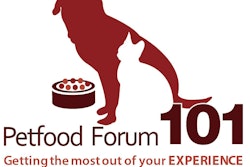U.S. pet obesity rates remained relatively unchanged in 2018, with 59.5% of cats and 55.8% of dogs classified as overweight or obese, according to the Association for Pet Obesity Prevention (APOP). During the 11th annual survey, APOP also found pet owners and veterinary professionals were confused by conflicting pet nutritional advice and continue to struggle to help pets achieve safe and ideal weights.
“Veterinarians need to offer more obesity treatment options than: Feed less and exercise more.” states APOP President, veterinarian Dr. Ernie Ward. “The majority of pet owners are overwhelmed with pet food choices and conflicting dietary advice and desperately want help and nutritional recommendations from veterinarians.”
In the October 2018 clinical survey, 36.9% of cats and 25.6% of dogs were classified as Overweight (body condition score (BCS) 6 to 7 on a 9-point scale). 33.8% of cats and 18.9% with Obesity (BCS 8 to 9) by their veterinary healthcare professional. That equals an estimated 56 million cats and 50 million dogs are Overweight or Obese, based on 2018 pet population projections provided by the American Pet Products Association (APPA). In 2017, APOP found 60% of cats (26.5% Overweight /33.5% Obese) and 56% of dogs (36.4%/19.6%) were Overweight or Obese.
Pet owners and veterinary professionals were questioned about pet obesity, diet and nutrition, and pet weight loss. 80% of veterinary professionals reported they had tried to help their pet lose weight, along with 68% of pet owners. The leading pet weight loss method was “calorie reduction/smaller portions” favored by 68% of all respondents. 61% increased exercise, 29% tried a low-calorie or low-fat pet food, and 19% fed a therapeutic or
“prescription” diet from their veterinarian.
When all respondents were asked what weight loss method was most effective, 38% rated calorie reduction/smaller portions as “very effective” and 33% ranked it as “somewhat effective.” 36% reported increased exercise as “very effective” along with 30% reporting it was “somewhat effective.” Only 9% reported low-calorie or low-fat diets as “very effective” while 23% reported it was “somewhat effective.” “Prescription weight loss diets” were given a 13% “very effective” rating and 14% “somewhat effective.” Further analysis of “prescription diet” revealed 50% of veterinary professionals and 70% of pet owners reported they “never tried” this weight loss method and 27% of veterinary professionals and 9% of pet owners ranked it as “very effective.”
68% of pet owners answered “Yes” to “Would you like your veterinarian to recommend a routine/maintenance diet for your pet?” compared to only 11% “I don’t really care.” Unfortunately, only 38% of pet owners reported their veterinarian had made a recommendation about the best routine/maintenance diet to feed their pet during the previous year. 22% said they “had to ask.” 40% replied they had received no dietary advice from their veterinary professional.
Two-thirds of pet owners agreed that “veterinarians are knowledgeable about pet nutrition.” 20% disagreed, and 13% said: “I don’t know.”
Pet owners were asked, “Please rank where you receive the best dietary recommendations for your pet.” Their rankings were: 1) Veterinary clinics, 2) Online/internet/website, 3) Pet store or Friend (tie), 4) Trainer, 5) Breeder, 6) Groomer, and 7) Other.
When it comes to diagnosing pet obesity, 53% of pet owners reported their veterinarian discussed their pet’s weight during their annual visit. 19% said “occasionally,” 20% “only when asked,” and 8% said “no.” 44% of all respondents reported they weighed their pet “every few months,” and 28% responded “yearly.” Only 15% weighed their pet monthly.
Additional survey results about pet food purchasing preferences, opinions on pet food ingredients, safety, and impact on health, and questions about plant-based and future pet foods will be released in April 2019.











